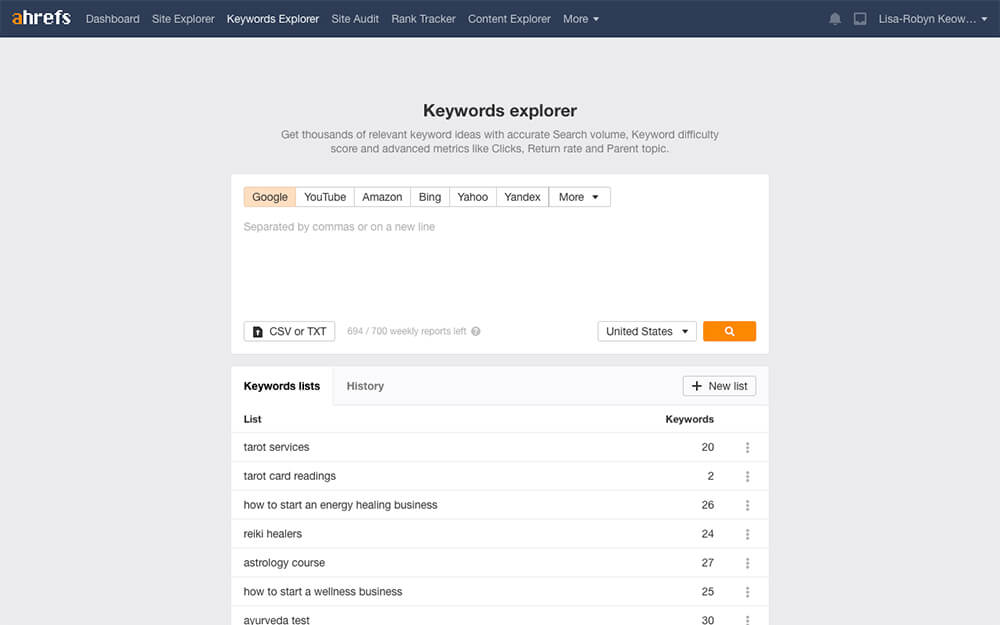One of the most confusing marketing strategies is search engine optimisation. The term ‘SEO’ is thrown around by marketers, and often, business owners don’t fully understand what it entails. As a business owner in charge of a website, it’s important to understand at least what SEO is and the basics of search engine optimisation.
When you first step into the world of marketing, it can be really daunting. Terminology can seem a little confusing, and SEO is often one of these.
Having a website with good SEO should be at the top of your business priority list, along with setting SMART goals. Let’s clear up all that confusion; here’s what you need to know about SEO basics.
In the following post, you’ll learn:
- What is SEO marketing
- Why you should use keywords in your copy
- How to format an article for best results
- SEO linking strategies
- The importance of page speed for search results
What is SEO Marketing
SEO or search engine optimisation improves the quality of a website by implementing various strategies aimed at improving organic traffic and URL positions in SERPs (search engine results pages). SEO is not one specific tactic, but rather encompasses a variety of different strategies; on-page SEO being one such strategy.
Because Google has become so good at finding what users are looking for, the best SEO experts know that creating a great user experience on your site is the best thing for SEO.
SEO for Beginners
So, if you’re just starting out with new brand, how do you improve the SEO of your site?
As mentioned above, there are a variety of tactics to employ. Here’s how you should be getting started.
Publish Interesting and Relevant Content
A search result is either a page or post URL that is suggested by a search engine to a person using the search engine itself. Including a content strategy via a blog feed, for example, will increase the number of URLs submitted to a search engine for indexing.
If you decide to create a blog post for your website once per week for a year, you’ll have an additional 52 URLs that can index in search results. If you treat each blog post as an answer to a question posed to a search engine, you’ll have more chance of having your content found by a potential customer.
Incorporating Keywords
Keyword research is a fundamental part of SEO. It’s important to understand what users are searching for, and what answer you are providing.
For example: If you own a reiki business in Cape Town, and a potential customer searches for “reiki services in Cape Town”, you’d like your website to appear in the Search Engine Results Pages, also known as SERPs.
Including keywords like this in the core pages of your site and within relevant blog posts will give your brand the chance of displaying favourably within search results.
There are many ways to do keyword research, but it involves finding words, terms, and phrases that users are searching for, and that are relevant to your website.

For example, if you own a tarot card reading business, and you’ve been publishing blog posts about various decks, card descriptions and pulls, you may be ranking for a term like “the emperor tarot card.”
While this might be relevant, there’s no purchase intent behind that search term. If someone searches “the emperor tarot card”, they’re more than likely searching for a meaning behind that card, or an image, rather than looking to buy tarot card reading session.
These keywords should be inserted into your page and post content, the most important ones as such should appear on your post or page as headings. This indicates to Google what the post or page is about, so it can rank it for the correct search terms.
Be careful of keyword stuffing as this can be harmful. Google may even penalise you for this practice.
Keyword stuffing entails trying to fit as many keywords onto your page as possible, and inserting them in sentences that don’t seem natural. Any great SEO guide will tell you that you shouldn’t have more than one keyword per paragraph (as a general rule).
Basics SEO Formatting
When it comes to formatting and structuring your post, you need to use formatted headings. You also need to ensure there is only one post title per page.
From a development perspective, these Heading Tags list in degrees from H1 to H6. A Heading 1 tag will become the post title, where Heading 2 and Heading 3 tags are generally used to break a large article into subheadings and subsections.

The heading structure also needs to work in a logical, numerical order, for example, a Heading 2 tag should be followed by a Sub-Heading 3 tag. It’s a good idea to add keywords in a natural-sounding way into the Heading tags as this will help the indexing of the content.
Structuring content in this way is not only important for search engines indexing content, but it also is important from a user experience perspective, as presenting well thought out sections to a reader makes the consuming content easier.
Linking
Next is the linking strategy. It’s essential to have a mixture of both internal and external links on each page or post.
- Internal links are links to pages and posts within your website.
- External links are links that are sent to other websites.
Internal links should link to other pages on your site. These should be attached to relevant anchor text. For example: How to install a Divi theme is an example of an internal link.
Adding external links to your page or post shows that you have used resources and makes your site more credible. As a general rule of SEO for beginners, you should try to stick to two external links per page or post. It’s important that you link to credible and authoritative sites that are not competitors of your own website.
If you make money through affiliate marketing, then affiliate links will also appear on the page. These affiliate links must appear naturally and must be relevant to what the post is about.
Make sure that all your internal links are do-follow links, and all your affiliate links are no-follow links. Whether or not you want to no-follow your external links is up to you. If you’re linking to authoritative sites, it may be beneficial to leave the links as do-follow.
Another basic SEO tip is to make sure your links open in a new tab. This way if someone clicks on a link, they are not necessarily leaving the first page they were on. Ultimately, you want users to stay on your page as long as possible until they convert.
Page Speed
You want to make sure your pages load as quickly as possible. There is an unwritten rule that a web page should take no longer than 3 seconds to load. If a page is taking a long time to load, users will become impatient and close the tab and try another search result.
Search engines aim to present the best web page result to a searcher, so a website that takes too long to display content will be considered as having a bad user experience. A website that is slow to load may cost you in search results.
You can check how quickly your page is loading with Google Pagespeed Insights.
Here are a few things you can do to make your pages load more efficiently.
- Reduce the size of images – this can often be done without compromising too much on quality. Unless images are a huge part of your site’s selling point, reducing your image sizes to less than 200kb can significantly increase the speed at which your site loads. You can also use a plugin to do this, but it can sometimes cause distortion. You can resize images using Adobe Photoshop or an online tool such as Resize Image, and optimise images using TinyPNG or Kraken.
- Minimise HTML – If you’re using a WordPress site, the easiest way to reduce unnecessary HTML is by working in the text editor rather than in the visual editor. Often, writing content directly into the Visual tab, or copying content from a Google Doc will result in additional HTML code or inline styles entering your content. These extra bits of code will need to be processed and can end up contributing to the page load speed.
Final Thoughts on Search Engine Optimisation Basics
These are some of the basic guidelines for on-page SEO. Search engine optimisation is an intricate process that has a lot of moving parts, but getting to grips with the foundation is vital to building a healthy site that indexes well and gets found in search results. It’s critical to understand and start implementing the basics, before moving onto some of the more complicated aspects of SEO.
Once you begin to implement these strategies on your website, you’ll start to see a significant increase in the rankings of your pages. Be sure to track the performance of your site on Google Analytics and Google Search Console. It’s always more exciting when you can see improvements taking place.
Do you have any questions about search engine optimisation strategies? Have you implemented some SEO basics into your website? Share your experience in the comments below!
Thanks for reading!





